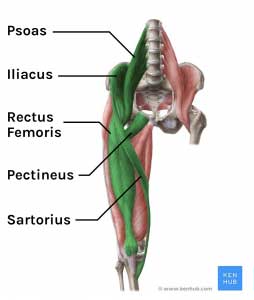Have you ever been sitting in the car, or at your desk and you start to feel an ache in the front of your hip? It might have even come on after a run or a cycle, well this is pretty common and you’re not alone. However, there can be a variety of different reasons why you might be getting anterior hip pain such as osteoarthritis or femoral acetabular impingement (FAI), but the reason that we will be discussing today is hip flexor pain.

What are the hip flexors?
The hip flexors consist of 3 key muscles that contribute to hip flexion: iliacus, psoas, pectineus, rectus femoris, and sartorius. Most of these muscles have other functions such as hip adduction, knee flexion and extension. The role of the hip flexors is to bring the knee up to hip height and flex the hip, exactly what it says on the tin.
Why would you get pain there?
Hip flexor strain or tear. A strain or tear refers to the damage caused to a muscle or tendon when it is stretched too far. Typically, a hip flexor strain or tear occurs when a person makes a sudden movement, such as changing direction while running. Muscle tears are classified on a grading system (mild to severe) that is mainly determined by how many muscle fibres are torn. Our physiotherapists here at Move Freely often work out how bad the tear is by the severity of pain, loss of motion, and weakness in the affected area.
Hip flexor tendinopathy. Tendons are the fibrous structures that attach muscle to bone. Hip flexor tendinopathy may be caused by an acute injury, such as from a fall or car accident, or by overuse, such as from running, gymnastics, or football. Additionally, hip flexor tendinopathy can occur with age as the tendons naturally lose elasticity.
Muscular overload. It is common to experience aches and discomfort-into the hip flexors when they are having to take more stress and strain from surrounding muscles not doing their job properly. For example, if the quadriceps or the glutes aren’t taking enough load during the activity then the hip flexor muscles can often bare the stress which results in aches and pains. This is by far the most common hip flexor we see in our sports injury clinic.
What is the best way to treat Hip flexor pain?
Like all conditions and injuries that are managed by physiotherapy, there are various ways to treat hip flexor pain and discomfort. Of course, the primary factor which dictates management comes down to the cause, for example, tendinopathies respond best to loading the tendons. This can be done in a variety of ways of different ways through Isometric exercises or exercises with a bias on the eccentric or concentric. Research has shown that taking a specific approach to loading the tendon doesn’t show any significant effect, rather than just loading the tendon in general.
In the situation where you have identified the hip flexors being overloaded due to weakness in surrounding muscles then the approach is often to strengthen these surrounding muscles. In doing this you build strength into those muscles so they are able to appropriately manage the load they are being placed under, thus reducing the referred stress to the hip flexors. This is one of the approaches we take to physiotherapy at Move Freely, by looking not only at where the symptoms are but at the body as a whole.
If you are searching for Physiotherapists in Edinburgh to help with your hip flexor pain, do not hesitate to get in touch. Our sports injury clinic is well-suited to help those with sporting injuries and general hip pain that has built up gradually.